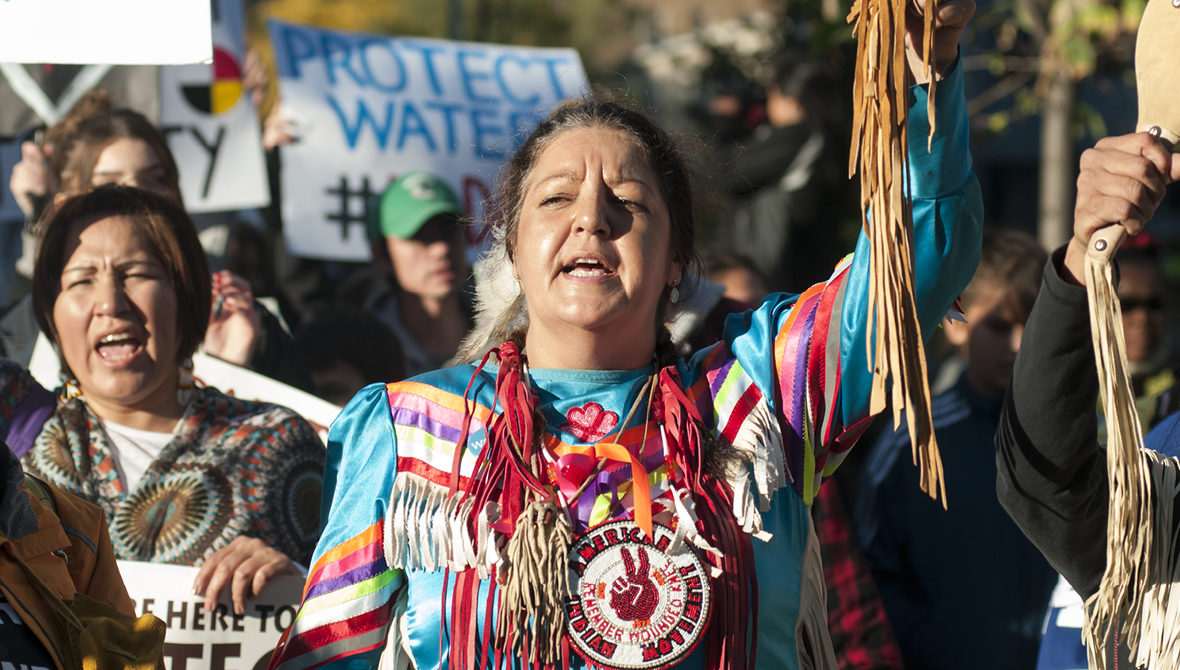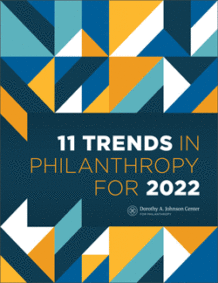Philanthropy is Entering a New Era of Engagement with Native Communities


 This article was first published in our 11 Trends in Philanthropy for 2022 report. Explore all 11 trends in the full report.
This article was first published in our 11 Trends in Philanthropy for 2022 report. Explore all 11 trends in the full report.
Want the latest trends, research, and more delivered right to your inbox? Subscribe to the Johnson Center email newsletter.
While Native American communities have been working for generations to support their lands, peoples, and cultures, institutional philanthropy has largely ignored — or actively hindered — that work for over a century.
In the last several years, however — marked by major events such as the stand-offs at Standing Rock in 2016 (Kavate, 2020), the publication of Edgar Villanueva’s Decolonizing Wealth in 2018, and the racial reckonings of 2020 — philanthropy has been experiencing a surge in awareness of the unique experiences, strengths, and challenges faced by Native American communities. Today, we see philanthropy entering a new era of engagement with Native communities.
Grounded in centuries-old traditions of giving as mutual responsibility, community care, and reciprocity, Indigenous people have historically pushed to resource their own communities (Konzen, 2019; Scott-Enns, 2020).
Within formal Native American philanthropic institutions, examples include Native-led foundations, tribal enterprise giving, community development financial institutions, and pooled funding collaboratives, as well as nonprofit funds. The American Indian Science and Engineering Society, the American Indian College Fund, and the Association on American Indian Affairs, for instance, offer scholarships and academic support, among other resources.
Due to current data reporting barriers, it is difficult to estimate how much funding Native-led sources give, but specific cases demonstrate Native philanthropic entities’ commitment to serving their communities. For example, Delgado (2006) found that from 2001–2003, Native-led foundations, nonprofits, and tribal funds disbursed over $122.5 million.
Research from the First Nations Development Institute (First Nations), reported by Frontline Solutions (2018), found that only 0.23% of philanthropic funds went to Native-led nonprofit organizations. A 2019 study from Native Americans in Philanthropy (NAP) and Candid, Investing in Native Communities, found that, on average, just 0.4% of total annual funding by large U.S. foundations was given to Native American communities and causes from 2002 to 2016.
Even in the midst of a historic reckoning on racial and social justice, the reality is dismal. Sixty-seven percent of nonprofit survey respondents who self-identified as serving Native American communities reported to the Center for Effective Philanthropy that their organization had received no new funding from their foundation supporters in 2020 (Martin et al., 2021, p. 20). In contrast, 52% of overall nonprofit survey respondents said their support from foundations increased in 2020 over 2019 levels (p. 13).
Yet, several large investments in global Indigenous communities in late 2021 may be cause for optimism.
NAP was included in the summer 2021 round of funding from Mackenzie Scott and received a $2 million gift (Kunze).
In September 2021, nine grantmakers signed on to the Protecting Our Planet Challenge. Made alongside their collective $5 billion commitment to conservation efforts was a pledge to work closely and differently with Indigenous communities going forward (Rendon).
First Nations and Candid’s report (2019) revealed that “Invisibility is one of the biggest barriers Native peoples face in advocating for tribal sovereignty, equity, and social justice” (p. 20).
Barron et al. (2020) drew connections between awareness, disinvestment, and the exclusion of Native Americans from the majority of foundation boards and staff. Research from CHANGE Philanthropy (Kan, 2021) and the Council on Foundations (2021) shows that Indigenous-identifying people make up a mere 0.7–0.8% of philanthropy professionals.
“The shift we are seeing today … is a palpable increase in the presence of Indigenous voices, stories, organizations, and partnerships at philanthropy’s many tables.”
The shift we are seeing today, then, is a palpable increase in the presence of Indigenous voices, stories, organizations, and partnerships at philanthropy’s many tables. Native American leaders, movements, and histories are appearing frequently on conference programs and plenaries across the field:
At the 2021 CHANGE Philanthropy Unity Summit, speakers included staff from the National Urban Indian Family Coalition, National Native American Boarding School Healing Coalition, Indigenous Peoples Task Force, and many others.
Researchers from the First Nations Development Institute and the University of Arizona presented together on Leadership and Gender Dynamics in the Native American Nonprofit Sector at the 2021 ARNOVA 50th Annual Conference (Ellenwood & Foxworth).
Land seems to be at the forefront of what philanthropy is paying attention to, catalyzed by Native advocates. Practitioners who have attended a recent conference or webinar will be familiar with the concept of a “Land Acknowledgment,” defined as “a formal statement that recognizes and respects Indigenous Peoples as traditional stewards of this land and the enduring relationship that exists between Indigenous Peoples and their traditional territories” (Northwestern University, 2021, para. 1).
“Land seems to be at the forefront of what philanthropy is paying attention to, catalyzed by Native advocates.”
While it is impractical to quantify how frequently land acknowledgments now appear during philanthropy networking and learning events, anecdotally they appear to be on the rise. Aided by the creation of the Native-Land.ca map in 2015, and its subsequent popularization by project administrator Native Land Digital, program attendees seem increasingly able to promptly share their own land acknowledgments in the “chat” feature — implying that awareness of recognizing Indigenous ancestral ties to land is growing rapidly.
Additionally, Land Back efforts — in the Black Hills of the Great Sioux Nation (Estes, 2021); the Delmarva Peninsula of the Nanticokes and Lenapes (Hedgpeth, 2021); the East Bay of the Lisjan Ohlone people and the Sogorea Te’ Land Trust; and elsewhere — are also making headlines and garnering philanthropic attention. This movement is about reclamation of Indigenous sovereignty, jurisdiction, and governance, as well as ancestral knowledge, language, and culture — entangled in centuries of broken treaties and unceded territory, tied to contemporary U.S. state and federal law, and today’s economic and social realities.
It remains to be seen whether the funding and resources necessary to begin moving the proverbial needle for Native communities will materialize. As major philanthropic institutions begin to voice support, actionable follow-through will be key. Native communities are forging pathways forward, and philanthropy is situated to help do the work in unprecedented ways — if it will reckon with the power dynamics and continued legacies of colonial systems in the field (Chitnis, 2018).



American Indian College Fund. (n.d.). https://collegefund.org
American Indian Science and Engineering Society (AISES). (n.d.). https://www.aises.org
Association on American Indian Affairs. (n.d.). Protecting sovereignty, preserving culture, educating youth, building capacity. https://www.indian-affairs.org
Barron, J., Egan, E., & Foxworth, R. (2020, December 3). Starting with hiring: How to welcome native leaders to the philanthropic sector. Nonprofit Quarterly. https://nonprofitquarterly.org/starting-with-hiring-how-to-welcome-native-leaders-to-the-philanthropic-sector/
Chitnis, R. (2018, November). Indigenous funds lead the way to decolonize philanthropy. Cultural Survival Quarterly Magazine 42(4). https://www.culturalsurvival.org/publications/cultural-survival-quarterly/indigenous-funds-lead-way-decolonize-philanthropy
Council on Foundations. (2021). 2021 grantmaker salary and benefits report. https://www.cof.org/content/2021-grantmaker-salary-and-benefits-report
Delgado, L. T. (2006, January 1). A demographic profile of independently incorporated Native American foundations and selected funds in the United States. Native Americans in Philanthropy. https://nativephilanthropy.candid.org/reports/a-demographic-profile-of-independently-incorporated-native-american-foundations-and-selected-funds-in-the-united-states/
Ellenwood, C. & Foxworth, R. (2021, November 18–20). Leadership and Gender Dynamics in the Native American Nonprofit Sector [Conference presentation]. ARNOVA 50th annual conference, Atlanta, GA, United States. https://cdn.ymaws.com/www.arnova.org/resource/resmgr/2021conference/2021_conference_program.pdf
Estes, N. (2021, January 1). The battle for the Black Hills. High Country News. https://www.hcn.org/issues/53.1/indigenous-affairs-social-justice-the-battle-for-the-black-hills
Ford Foundation. (2021, November 1). Governments and private funders announce historic US $1.7 billion pledge at COP26 in support of Indigenous Peoples and local communities. https://www.fordfoundation.org/the-latest/news/governments-and-private-funders-announce-historic-us-17-billion-pledge-at-cop26-in-support-of-indigenous-peoples-and-local-communities/
Frontline. (2018, July). We need to change how we think. First Nations Development Institute. https://www.firstnations.org/publications/we-need-to-change-how-we-think-perspectives-on-philanthropys-underfunding-of-native-communities-and-causes/
Hedgpeth, D. (2021, November 28). Two American Indian tribes in Delaware get help in buying back part of ancestral homelands. The Washington Post. https://www.washingtonpost.com/dc-md-va/2021/11/28/native-american-land-buy-nanticoke-lenape/
Kan, L. M. (2021, August). The 2020 diversity among philanthropic professionals report. CHANGE Philanthropy. https://changephilanthropy.org/wp-content/uploads/2021/08/The_2020_Diversity_Among_Philanthropic_Professionals_Report.pdf
Kavate, M. (2020, July 28). Native American activists make gains, but philanthropy “Continues to scratch the surface.” Inside Philanthropy. https://www.insidephilanthropy.com/home/2020/7/28/native-american-activists-make-gains-but-philanthropy-continues-to-scratch-the-surface
Konzen, K. (2019). Native American philanthropy. Learning to Give. https://www.learningtogive.org/resources/native-american-philanthropy
Kunze, J. (2021, June 15). Indigenous nonprofits included in philanthropist MacKenzie Scott’s latest $2.74B round of donations. Tribal Business News. https://tribalbusinessnews.com/sections/economic-development/13526-indigenous-nonprofits-included-in-philanthropist-mackenzie-scott-s-latest-2-74b-round-of-donations
Martin, H., Gehling, K., & Buteau, E. (2021, June). Persevering Through Crisis: The state of nonprofits. The Center for Effective Philanthropy. https://cep.org/wp-content/uploads/2021/06/CEP_Persevering-through-Crisis_2021.pdf
Native Americans in Philanthropy; & Candid. (2019). Investing in Native communities. https://doi.org/c9wj
Native Land Digital. (n.d.). https://native-land.ca
Northwestern University. (2021). Land Acknowledgment. Native American and Indigenous initiatives. https://www.northwestern.edu/native-american-and-indigenous-peoples/about/Land%20Acknowledgement.html
Rendon, J. (2021, September 28). $5B conservation plan offers new approach, but faces hurdles. AP News. https://apnews.com/article/climate-change-science-business-philanthropy-oceans-6ca70181c532be88358cbedda72dce1e
Scott-Enns, I. (2020). Indigenous ways of giving + sharing: Indigenous-led Funds landscape scan report. International Funders for Indigenous Peoples. https://internationalfunders.org/wp-content/uploads/2021/03/IFIP-Indigenous-Ways-of-Giving-and-Sharing-Landscape-Scan-Report-1.pdf
Sogorea Te’ Land Trust. (n.d.). The East Bay is traditional Lisjan Ohlone land. https://sogoreate-landtrust.org
Timko, K. & Penn, M. (n.d.). 2021 virtual conference. Alliance for Nonprofit Management. https://allianceonlinecommunity.org/page/indigenous-peoples-day-acknowledgment
Villanueva, E. (2018). Decolonizing Wealth: Indigenous wisdom to heal divides and restore balance. Berrett-Koehler Publishers.